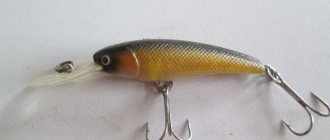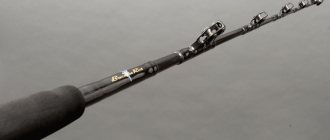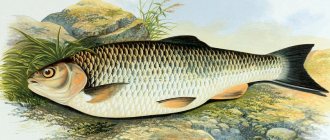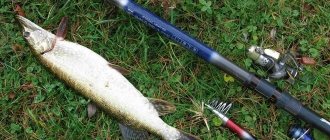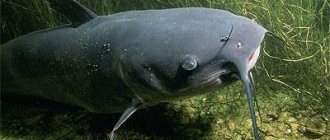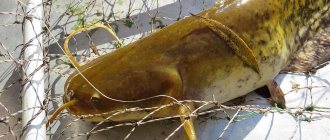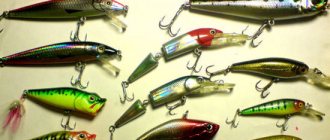Yuri 10/12/2020 184
Catching catfish with a spinning rod requires serious preparation from the angler. It is necessary not only to first study the features of the bottom topography of the local reservoir, but also to have an idea about the lifestyle of the river ruler and his habits.
The largest freshwater fish offers decent resistance when fished. Therefore, properly mounted spinning tackle is one of the important components for successful hunting.
Where to look for catfish
Catfish is a fish that lives in rivers and flowing bodies of standing water throughout Europe. Most often, this fish can be found in the river basins: Dnieper, Volga, Dvina, Neman, Vistula, Odra, Danube. There is a lot of this fish in the basins of the Syr Darya and Amu Darya rivers, and this is not the whole list where catfish are found. Catfish do not tolerate cold water well.
How to make and attach bait
Properly prepared bait is half the success of catfish hunting. If you use silver bream or, as the locals also call it, tarashka, then you should choose a fish weighing about 200 grams. From the back of the fish you need to cut a small piece 10-12 cm long and about 2 cm thick, maybe a little more. When making a cut, you need to try not to touch the ridge.
Thread a piece of fish onto a tackle that has a powerful double hook. The first hook is inserted deep inside the bait, and the second is carefully attached to the side, pressing tightly against the piece of fish. For greater reliability, the bait should be wrapped with thin wire on top. If you make the bait larger, you will have to select a heavier sinker.
Most often, when hunting for catfish, a head weighing 30-35 g is used, but this is if the fishing takes place in a relatively calm place at medium depth. If the current is strong and the depths are significant, you need to use more powerful heads weighing up to 50 g. In this case, you should act carefully.
The chances of ambushing a catfish at great depths are higher than in medium waters, but not every fishing rod can withstand such a load without consequences.
Lures
The best artificial baits for catfish are:
- Large oscillating spoons. This type of bait can only be used in places where the bottom is sufficiently clean, where there are no tree roots, submerged objects, or snags on the bottom;
- Deep-sea large wobblers (the preferred form is a minnow or an exact imitation of a ruff) This type of bait can only be used in places where the bottom is sufficiently clean, where there are no tree roots, submerged objects, or snags on the bottom;
- Jig baits (twisters, slugs, frogs), which work well in early spring, when catfish are just emerging from hibernation and hunting for everything that moves. This type of bait can be used in combination with an offset hook in the most difficult places for any spinning angler - in snags and dense thickets of aquatic vegetation.
- Surface baits (poppers, artificial mouse, frog imitation). It works best in the heat of summer and when catfish are active in the fall. There are different techniques for catching catfish with live bait.
Advice! You need to choose bait for catfish based on the activity of the catfish in the pond. If the catfish rises to the surface (characteristic squelching sounds are heard), then it is better to prefer surface baits. If the catfish is not visible or heard at the surface, then you need to use bottom baits.
Spinning fishing technique
When catching catfish with a spinning rod, it is necessary to take into account the slowness and sedateness of this fish. Large individuals will not chase fast-moving twisters and wobblers, especially if they move high above the bottom. Therefore, the main parameters of wiring are a smooth, uniform movement at the very bottom.
- If it is a wobbler, then it is important to deepen it so that it moves from the bottom no higher than 25-30 cm.
- Jig fishing is used when using heavy spoons and silicone fish.
The catfish bite resembles a light poke while the bait is immersed. After hooking, the large fish tries to escape at a constant speed into the shelter, and the small catfish run away in jerks.
| Fishing in spring | In summer | in autumn |
| In the spring, you need to catch catfish close to wintering pits. The fish comes out to the shallows, where they look for food. The best time for fishing is the second half of the day. When the water warms up to a temperature of 15-17⁰C, the pre-spawning feast begins. You can catch it with any bait, both in deep and shallow water. For deep fishing, spinners and jig baits are used, which lead in a slow “step”. At shallow depths, you can use wobblers or light spoons. Here the wiring should be slow and even. | When the water temperature reaches 15-20⁰С, the catfish begins to spawn. This period can last 3 weeks. During spawning, only small catfish are caught. And after spawning, the second period of active feeding of the fish begins. In hot weather, the catfish switches to night feeding, and it is possible to catch it only early in the morning or late in the evening. In summer, daytime bite is possible in cloudy and rainy weather. It is better to fish near various shelters, depth changes, and near dams. Wobblers and spinners work best with even wiring. | A good time of year for spinning catfish fishing is autumn. Especially when there are light frosts at night. The fish intuitively moves to wintering places, feeding heavily at the same time. Jig fishing with heavy oscillating spoons and large vibrating tails becomes effective. Fishing with deep-sea wobblers with a noise effect can be carried out before the onset of winter. When the water temperature drops to 7⁰C, the catfish goes into hibernation and does not respond to the bait of a spinning rod. |
St.Croix spinning rods are professional spinning rods that can help you catch a freshwater giant. About the features of the models and choosing the right spinning rod in the article.
Shimano spinning rods - the best models and features.
Black Hole spinning rods are models and application features that have long won the hearts of fans of spinning fishing.
Ways to animate baits
Catfish is, of course, a large and slow predator, but it is still a predator, so the following are suitable for animation of bottom baits:
- Classic stepped wiring;
- Dragging along the bottom;
- Stop&go;
For fishing with surface, floating baits, jerking techniques are used.
Advice! The main thing is that the bait behaves in motion as realistically as possible. And speed. You should always remember that wiring should be done slowly.
What to catch catfish with
Fishing with a spinning rod on duty, so beloved by many fishermen, is not a good idea.
When choosing a fishing tool, you should prefer a regular donka or something similar. In this case, self-catching fishing rods are suitable, which are convenient to hold while waiting for a bite. If you prefer active hunting, then give preference to the quok. Despite its little popularity in our area, this principle of fishing has become widespread in the central and southern rivers of Europe. Kwok is perfect for catching catfish in the deep southern rivers of our country.
Fishing with kwok is suitable for companies and less successful for lone fishermen. By simultaneously organizing catfish fishing from two or more boats, you can guarantee a greater number of bites than a single fisherman.
Therefore, for a successful catfish hunt, you need to choose the right fishing rod and join the fishermen. This method most likely inflames the excitement of the catfish, so a group of spinners has an increased chance of catching a catfish.
Having decided on the choice of fishing rod and fishing method, you should prepare the bait. Catfish have a very developed sense of smell, so you need to try to ensure that the bait does not absorb foreign odors, as happens with vibrotails and twisters, but smells like fish.
Catching catfish
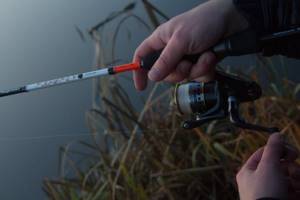
You can catch this fish:
- From shore to cast;
- From the side of the boat, casting or trolling or “track”;
The second option is preferable.
It allows:
- fish large areas;
- allows you to move faster through a body of water and reach places where not all gear can be thrown from the shore;
- when fishing for a large catfish, follow it throughout the entire body of water;
- stun the catfish at the moment when the fish needs to be pulled out of the water.
Trolling or “track”, especially at dusk, makes it possible to fish using several spinning rods at once, which increases the chances of a catfish biting. Many fishermen noted that in places where catfish were caught only as bycatch, the use of a boat and trolling gear made it possible to purposefully catch catfish and the catches increased several times.
If you don't have a boat, it will be a big disadvantage if a trophy catfish lands on the hook. It is already difficult to pull a strong fish from its place. A catfish that is full of strength and has just been spotted will definitely try to go into hiding.
It can only be stopped by wrapping a fishing line around a tree. And it’s not a fact that this action will somehow help. Most likely, a trophy catfish will break the tackle or pull the bait so far into a snag or some thickets that the fisherman will have to cut the line himself.
But trophy catfish are not caught so often. And you can handle an ordinary catfish weighing up to 20 kg from the shore.
How to catch catfish using a spinning rod from the shore and from a boat
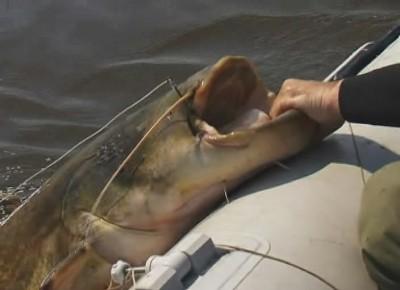
To lure it out when fishing from a boat , various devices are used. The most common is kwok . Kwok is used from a boat. The bait hangs from the boat to a depth of 2-3 meters from the bottom (depending on the depth of the hole in which the catfish can stand), and the fisherman croaks through the water and makes sounds similar to slurping.
The catfish thinks that another predator is having lunch, but he will never tolerate a rival nearby, and will definitely come out of hiding. This is where the dangling bait catches his eye.
They also use an odorous lure : a bag of rotten fish and bait are hung under the boat. Catfish have a good sense of smell; besides, they are scavengers and can detect this smell at a great distance. He will come up and hit the bait.
Bait can be:
- slave,
- frog,
- cancerous cervix,
- bunch of worms,
- shell meat,
- stag beetle larva,
- called “oil seal”,
- meat of animals and poultry.
From the shore, catfish are caught only at night and using bottom tackle : a sinker on the bottom, and a leash of 20-30 cm. with a 2 or 3 hook hook.
The bait is the same as when fishing from a boat , but you can also use live bait. Bait : rotten fish, submerged in a bag not far, or better yet, a little upstream, from the bottom fishing rods.
- 5 secrets of catching crucian carp - exclusive material for our readers!
- Are you planning to catch asp using a spinning rod? Then this article is for you.
- Traditional fishing for non-traditional fish - taimen on a spinning rod
The process of catching.
- We choose a place. We have already considered the selection criteria. We measure depths using a depth gauge. Reconnaissance by casting a “Cheburashka weight” to a potential fishing spot will allow you to determine the nature of the bottom and the presence of possible shelters for catfish at the bottom. And if you use sonar, you can find out if there is a catfish in those places. Using an echo sounder is not exactly a sport, but it can provide a lot of useful information.
- We equip spinning rods. The choice of bait is an individual matter. It's difficult to give advice. In each specific place at different times, any of the artificial baits available in stock can work. The main thing is that it should be large enough in size, because catfish eyesight is not very good.
- We cast to the area where the catfish may be found. We wait until the bait reaches the bottom (a blow is felt in the handle of the spinning rod, the tip “plays back” and returns to its original position).
- Let's start wiring. We slowly move the bait, stopping and lifting it above the surface of the bottom, raising a small amount of turbidity on the bottom.
- If there is a bite, we make a powerful hook and loosen the brake clutch. Then we jerk the rod in the direction of a possible shelter for the catfish. The fish will definitely go in the opposite direction. Then the struggle begins, during which the catfish must be physically exhausted before being pulled aboard the boat or ashore. As soon as its jerking stops, you need to slightly tighten the clutch and drag the fish in the direction of the landing net or hook.
- If the catfish is large, the fish is usually killed using a special hammer and only then taken out of the water. If the catfish is small, you can simply take it into the landing net and, after freeing it from the hook, release it back into the water. If the catfish is exhausted, then at the final stage it does not offer much resistance. But a large catfish can finally show its character - make a powerful jerk, hit with its tail. And his blow is serious.
Advice! It is not customary to take fish weighing less than 3 kg from professional fishmongers. Most often, this is an immature catfish that still has a long life to live.
Tackle for catfish
Remember the most important thing is that the tackle for catfish must be proven, very powerful and durable. At the moment when the monster sticks to the bottom, it can only be moved from its place with a powerful rod, and of course a power reel of size 4000 according to the Dive classification. As the main fishing line, I use a cord with a diameter of 0.2 according to the Japanese classification. This is quite enough to pull a large river inhabitant weighing 8-10 kilograms ashore. Now let's talk in more detail about the gear. How to choose the right gear and not make a mistake? Let's talk about this now.
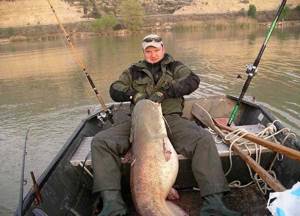
How to choose a spinning rod for catching catfish
As was previously said, when fishing for catfish, spinning rods must withstand heavy loads. The most important thing in this situation is to choose a normal limit in the test of the rod and another important thing is the structure of the blank.
A lot depends on the structure. An overly rigid rod can lead to fish loss, but a moderately parabolic action allows us to preserve the catch and bring it to the shore or boat.
A spinning rod with a powerful butt and a flexible tip is necessary only then will we be confident that we will be able to lift the catfish from the depths. It is advisable if the stick has large access rings. The line comes off easily from large guides and they are usually strong.
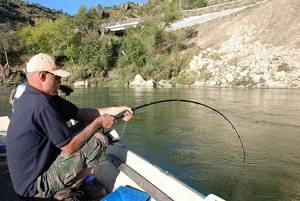
How to choose a reel for catching catfish
The requirements for a reel are even more stringent than for a spinning rod:
— Firstly, you need a good smooth ride and a complete absence of backlash; — Secondly, you will need a large spool and a powerful friction brake; — Well, thirdly, a low gear ratio, say 4:2:1, only then will the tackle be balanced and reliable.
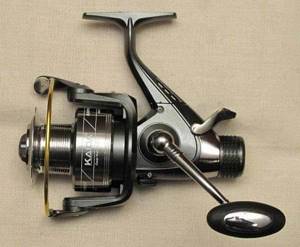
Which braid to choose for catching catfish
Braided line experiences the most stress throughout the entire fishing trip. From personal experience I will say that I have tried a lot of cords. But for the last three years I’ve been fishing exclusively with eight-strand ones.
They have zero elongation and high sensitivity, plus such cords are resistant to abrasion. And, if we take into account that the fishing will be carried out on the bottom, where there is a lot of snags, shells and other things, then the cord will gradually wear out, and at one point it can break even on a small fish.
Catfish do not have such large teeth as pike, but with normal effort they can grind the braid, so you should not give up the leash. An ordinary string would be out of place here, but a titanium leash with a reliable swivel and clasp is just right!
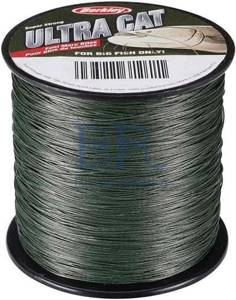
3 ways to improve your fish bite!

Over 15 years of active fishing, I have found many ways to improve the bite, and here are the most effective:
1. Bite activator . This pheromone additive attracts fish most strongly in cold and warm water. The Fish Hungry bite activator has proven itself to be excellent - Read more…
2. Tackle with increased sensitivity . You should first familiarize yourself with the features of using a particular type.
3. Pheromone baits . They attract the attention of fish, stimulate hunger and cause a schooling reflex, which allows you to collect a lot of fish in one place.
You can get the rest of the secrets of successful fishing for free by reading my other materials on the site.
3 ways to improve your fish bite!
Over 15 years of active fishing, I have found many ways to improve the bite, and here are the most effective:
1. Bite activator . This pheromone additive attracts fish most strongly in cold and warm water. The Fish Hungry bite activator has proven itself to be excellent - Read more…
2. Tackle with increased sensitivity . You should first familiarize yourself with the features of using a particular type.
3. Pheromone baits . They attract the attention of fish, stimulate hunger and cause a schooling reflex, which allows you to collect a lot of fish in one place.
You can get the rest of the secrets of successful fishing for free by reading my other materials on the site.
What is lipgrip for?
And finally, the last question, which is technically related, is lipgrip. If you can call it a device, then consider it that way. In short, this device is designed to grab large-sized fish by the mouth.
It is difficult to lift a catfish with your bare hands and no landing nets will work here, but the lipgrip can withstand heavy loads. Take note of this, and if you don’t have it, I strongly recommend that you buy it, and life will become easier!
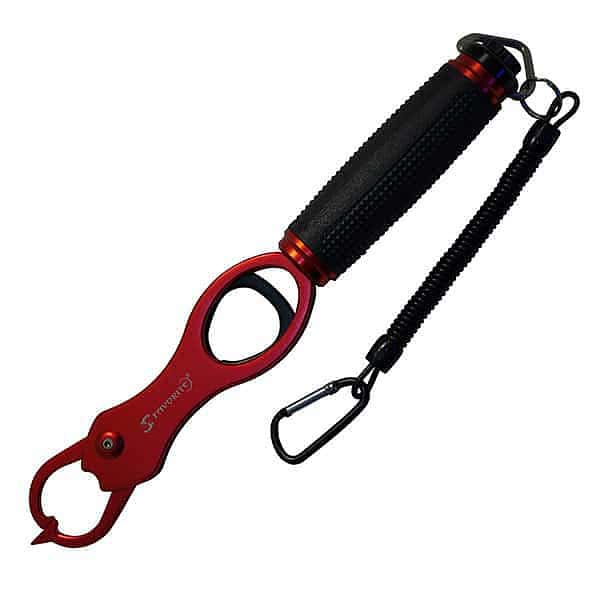
Review of gear for catching catfish (Video)
Shore fishing technique
There are several ways to catch catfish. The most common method of catching catfish is jig fishing. In this case, stepwise wiring is used: it is necessary for the bait to move in weak jerks, imitating the behavior of a wounded or sick fish.
Often, stepwise wiring is used: 2–3 turns of the coil, followed by a slight jerk. Then again a few turns and a jerk again, etc.
In this case, you should carefully “probe” the entire bottom so that not a single meter of unchecked area remains in the area where the fish are supposed to be located.
When fishing with wobblers, the bait moves directly near the bottom, touching it from time to time and creating turbidity. From the outside it may seem that the fry is feeding in this way.
Similar to jig tactics, every meter of potential territory where catfish may be located is examined in a similar way. Step wiring is also used here, however, it is done a little more often.
When using lures, a large lure is pulled along the bottom, creating a cloud of turbidity. Wiring is carried out by the usual winding of the fishing line, and each subsequent stage of wiring should be done after a short pause.
The catfish bite is quite sharp, very similar to a dead hook, however, after a few seconds the fish begins to resist. The catfish instantly sucks up the bait (since it has no teeth), and it is necessary to make a sharp hook so that the hook enters the hard skin of the fish’s mouth as firmly as possible.
Usually, catfish never get off the hook, but landing a catfish is a very tedious process that can last up to an hour, or even more. The catfish must first be thoroughly exhausted so that it is exhausted, and only after that it must be gradually dragged to the shore or boat.
Throughout the entire fishing period, you should not give in to slack, since the fish can either go into a snag or suddenly accelerate and break the line.
Fishing for catfish by trolling
The behavior strategy after the fish has bitten depends greatly on your gear and the weight of the fish.
A Repp-965, a Banax ISO 2000 rod, or similar powerful gear makes it possible to start competing with catfish immediately, provided that the weight of the fish does not exceed a pound. With such equipment, there is no fear of experiencing defeat and losing gear.
If the catfish is larger, and the tackle is not so powerful, you will have to start a thoughtful and careful fight. First, making sure that the specimen is large, hurry to untie the anchor. When the bottom is free and the supply of fishing line is sufficient, there is no point in holding the catfish tightly - it cannot escape.
There is an exception. For quok fishermen, the length of the fishing line is twice the depth of the largest hole. In the described example, the reel should contain 150-200 m of fishing line with high reliability.
If the bottom is covered with snags, the catfish cannot be released. It must be braked smoothly and restrained, which is not easy. The catfish is a decent fish, even a small specimen, once hooked, can suddenly rush into shelter under a snag and it will not be easy to fish it out. That is why it is important to notice the bite in time and tighten the clutch more than usual. This will make it possible to stop the catfish without delay.
The catfish, leading the fisherman, does not make particularly tricky maneuvers, but it has a large mass and therefore it is not easy to compete with this strong fish. His endurance and tenacity delay the fishing process. At the same time, you need to be patient, because the fleshy lip of the catfish usually penetrates the hook deeply, and it can be very difficult for the fish to break free, so there are practically no failures. If the bottom is clean, catching catfish is a matter of time.
You should remain calm and confidently hold the rod, ready for battle. The main tactic is not to let the catfish rest; it can lie deep at the bottom and here its patience is inexhaustible. Strong tension on the fishing line and rhythmic tapping on the rod will help you avoid getting stuck. Try to bring the fish to a shallower part of the river, closer to the shore, it will be easier to catch catfish here.
Kwok is a simple device that serves as a kind of decoy for catfish. The sound of the quok is associated with safety, tranquility and prey in catfish. As the experience of many fishermen has shown, the ratio of fishing yield with and without a quok is 10:1.
Catfish fishing for kwok is done from a boat in a plumb line. The choice of equipment for catching catfish must be taken seriously, since with the help of a quok you can provoke a bite not only of 10-30 kilogram catfish, but also of 80-100 kilogram giants.
Therefore, to catch it, sea fishing rods 1-1.8 m long, with 100-300 grams of dough, are used. As a material, you should choose rods made of fiberglass and graphite.
The action is super-fast, it will allow you to make a hard sweep even with one hand from an awkward position. Much attention should be paid to the passage rings, which should be large, metal without ceramic inserts.
Don’t forget about a high-quality reel seat; under no circumstances should it be made of plastic. The reel is a powerful multiplier for sea fishing; 60-70 m of fishing line is wound on it, capable of withstanding a breaking force of up to 100 kg.
The sinker is used either blind or sliding, the main thing is that the bait is 30-50 cm from the bottom.
The lead is 30-50 cm long with a blind sinker and 70-100 with a sliding weight, made of titanium or Kevlar. Large hooks 3/0 - 6/0 made of hardened steel. Do not forget about the reliability of swivels and carabiners; they must also be designed to withstand a breaking weight of 100-120 kg.
Some fishermen fish without a rod, and use a nylon cord with a diameter of 3-4 mm, wound in a figure eight on a reel, as a fishing line.
Kwok is made from brass, aluminum or wood (maple, ide, apple). The advantages of fishing for catfish with a wooden hook are its stronger sound and buoyancy, since even experienced fishermen sometimes let go of this bait. Although hollow metal quotes can also float on water.
Making kwok
Kwok consists of a handle, a knife and a heel. To make a kwok, take a plate 280 mm long, 5 mm thick and 25 mm wide; it will serve as a knife.
The handle is cut to fit the hand, using the dimensions shown in the figure as the basis. At the bottom of the handle you need to cut a groove into which a knife is inserted at a specified angle using glue.
It is better to wrap the connection point and the handle with insulating tape. At the end of the knife, a mold is made from plasticine for the heel, the kwok is installed so that the handle is vertical, then epoxy resin or other quick-hardening material should be poured into the mold.
When the resin hardens, the plasticine can be removed.
The knife and heel are processed so that there is no sharp edge left at the heel. The knife is given a streamlined shape, after which it is polished.
Also, the kwok is soaked in olive oil or opened with varnish for moisture resistance. The heel can be made of wood.
A groove is made in the heel into which a knife is inserted, the heel and knife are glued together. In cases where the snout and knife are made of metal, they are riveted, soldered or boiled.
The heel can be either flat or convex.
The kwok must be ground and polished with high quality; there should be no burrs, cracks or roughness.
Kwok work
Fishing for catfish with a quok is successful when using it from a depth of 2.5 m, although the sounds should be made quieter than when fishing at a depth of 8 m, where a powerful sound is needed to attract fish. The water should be calm, since even with small waves it is quite difficult to reproduce the necessary call.
The kwok should not be in one hand with the cord. It is taken in your hand in such a way that there is an angle of 45-50 degrees between its handle and your forearm.
Then we sharply and confidently extend our arm and the quok enters the water, while the shoulder remains motionless. After the quok enters the water, we begin to turn the shoulder until the handle of the quok assumes a horizontal position.
At this moment, the brush comes into play, turns sharply and quickly removes the heels from the water. A beginner will definitely produce a lot of splashes, so having achieved a soft gurgling sound mixed with the sound “kv” in which there will be almost no splashes, you can begin to hope for success.
The croaking technique is different, you can make one quack strike, and then, after counting “one, two, three,” hit the “fourth”, after repeating the procedure throughout the entire catch, or make single strikes every 15-30 seconds. You can do 2-3 blows every 1-2 minutes.
It happens, especially at the end of fishing, when none of the above methods help, you start croaking continuously, and the catfish bites.
To catch catfish by trolling, use a donkey or a spinning rod. For the donkey, take a spindle-shaped sinker, which is attached 30-50 cm from the hook; the weight of the sinker is selected based on the fact that a slow sailing boat should drag the line at an angle of 45 ° to the water surface.
When fishing with a spinning rod, the bait is a heavy wobbler. At greater depths, a steel frame is used to hold the wobbler at the desired depth.
A piece of wire bent at an angle of 90° serves as a frame. At one end a sinker is attached to the second end with a wobbler.
Fishing for catfish by “trolling” requires knowledge of the bottom topography, otherwise frequent snags cannot be avoided
